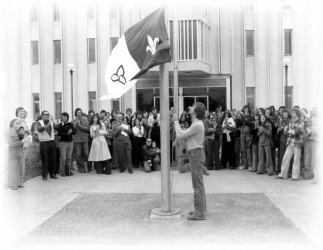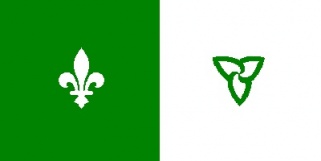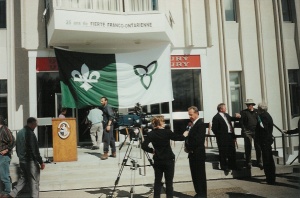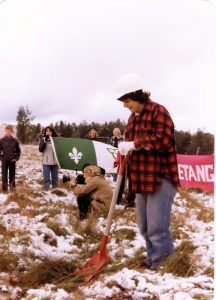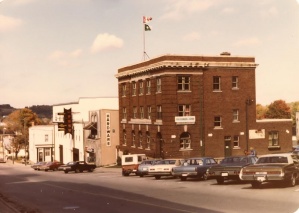Franco-Ontarian Flag
par Saint-Pierre, Stéphanie
When the Franco-Ontarian flag was raised for the first time at the University of Sudbury on September 25, 1975, its two designers, Michel Dupuis and Gaétan Gervais, preferred to remain anonymous. They wanted the flag to serve as a unifying symbol for all Franco-Ontarians without it being linked to any particular group, such as the Sudbury community or Laurentian University. Their gamble paid off. Since its creation, the Franco-Ontarian flag has been embraced as the visual emblem of the entire Franco-Ontarian community and is proudly flown at festivals, celebrations, rallies, and demonstrations throughout the province.
Article disponible en français : Drapeau franco-ontarien
The
white of our winters and the green of our summers...
Since "the effectiveness of a symbol always lies in its simplicity,"(NOTE 1) the Franco-Ontarian flag, like other emblems, makes use of classic design and limits the use of colour. It is divided into two equal halves: on the left, a white Fleur-de-Lys against a green background and on the right, a green trillium against a white background. The Fleur-de-Lys symbolizes membership in the wider Freach-speaking community, while the trillium affirms Franco-Ontarians' profound attachment to their native province of Ontario. As for the choice of colours, Gervais and Dupuis wanted to avoid all political connotations. Since red and blue were already identified with political parties, they were ruled out. It was only later that the flag's creators lent their choice a poetic justification when they affirmed that the chosen colours recalled the white of our winters and the green of our summers.(NOTE 2)
A
Symbol for All
The Franco-Ontarian flag is much more, however, than the mere sum of its parts, which have been slightly modified since 1975.(NOTE 3) Its heritage value resides in the history of its use and the symbolic significance it has acquired among Franco-Ontarians. Although it took time for the flag to be accepted as the common symbol of this heterogeneous community, it unquestioningly fills that role today. As early as 1977, Association Canadienne-Française de l'Ontario [French Canadian Societthy of Ontario] seems to have officially adopted the flag. However, as Tina Desabrais explains, it was the education system that "played a major role in promoting the emblem and spreading awareness of it in the various communities."(NOTE 4) In 1979, the Ministry of Education of Ontario declared that there was no rule against the Franco-Ontarian flag being flown at schools on the condition that it be flown alongside the Ontario and Canadian flags. Today, Franco-Ontarian schools even hold "flag day" celebrations on September 25th of each year.
However, the symbolic role of the Franco-Ontarian flag goes beyond its use in the area of education. The flag is also flown at events like Nuit sur l'Étang and Festival Franco-Ontarien, at demonstrations and rallies, and in front of government offices and agencies, as well as certain businesses.
History and Evolution
The Franco-Ontarian flag is the result of a period that could be called the "Cultural Revolution" in French-speaking Ontario. In the early 1970s, numerous cultural and artistic initiatives emerged in the province, particularly in the Sudbury area. These included the founding of the publishing firm Prise de Parole, Théâtre du Nouvel-Ontario and Galerie du Nouvel-Ontario, all of which still exist today. These intiatives also include the artists' cooperative Coopérative des Artistes du Nouvel-Ontario (CANO) and CANO-Musique, whose cultural influence continues to resonate within the province's arts community today.
Given the context, the 1970s were conducive to the creation of a unifying symbol for a community seeking to define, or rather redefine, its role in Canada following Quebec's Quiet Revolution at a time when the term "French Canadian" was falling out of use. Gaétan Gervais, a history professor at Laurentian University, and Michel Dupuis, a second-year political science student, were the instigators of the project. Over the course of their meetings and discussions in the "Grand Salon" at Laurentian University, the Franco-Ontarian flag began to take shape. Gervais tells it this way:
We gathered scissors and coloured cardboard and tried different combinations of symbols and colours. The idea was to find a symbol that represented Franco-Ontarians.... We narrowed it down to the current two symbols. I think we found the Fleur-de-Lys in a dictionary and the trillium on an Ontario government envelope.(NOTE 5)
They then approached Jacline England, the secretary of Student Life at Laurentian University, who took on the task of sewing the first Franco-Ontarian flag.(NOTE 6) Then came the official unveiling. Dupuis describes the memorable event: "On September 25th, helped by a breeze that seemed to have been specially ordered for the occasion, a brand new symbol, the Franco-Ontarian flag, floated for the first time from the flagpole at the University of Sudbury."(NOTE 7)
The choice of the University of Sudbury for the ceremony was obvious because of its affiliation with Laurentian University and its symbolic importance for Sudbury's French-speaking community. This French-language Catholic institution was founded in 1957 by the Jesuits, who also ran Collège du Sacré-Cœur, a classical college established in Sudbury in 1913. When Laurentian University opened in 1960, the University of Sudbury became an affiliated college, but today, it maintains a degree of administrative autonomy
After the unveiling, the flag did not immediately catch on with Franco-Ontarians, as Tina Desabrais documents in her study in Le Drapeau Franco-Ontarien. One month after the ceremony, the flag was presented for the first time outside Sudbury at a provincial convention of Association Canadienne-Française de l'Ontario in Timmins. At the meeting, two groups proposed different versions of a "Franco-Ontarian flag," the one we are familiar with today, and a different version created by a group of cultural organizers from Ottawa. One member of the Ottawa group proposed submitting the two flags to a vote by convention participants, a suggestion opposed by the Sudbury group. As Gervais recalls, "We told him that it wasn't worth discussing since the name was already taken" As a matter of fact, Gervais and Dupuis had already taken steps to register the flag with the Copyright Office.(NOTE 8)
Since its creation in 1975, the history of the flag has become so intimately linked with that of French-speaking Ontario that, at times, it is almost impossible to separate the two. Moreover, the evolution of flag-related imagery testifies to the community's attachment to this widely embraced and frequently modified symbol that often appears in numerous logos, publications, and letterheads.(NOTE 9)
Since 1977 and its adoption by ACFO, the flag has played a role in virtually all of the key events in Franco-Ontarian history. It was first used in a rather limited fashion(NOTE 10) during the fight to obtain a French-language high school in Penetanguishene.(NOTE 11) During the struggle for the school, on September 1st, 1979, a group of activists carried the flag to the cottage of the then Premier, Bill Davis. Furthermore, it was also flown at École de la Résistance.(NOTE 12)
The flag was a familiar sight during the 1980s and 1990s at rallies and demonstrations in support of French-language postsecondary education, whether for a Franco-Ontarian university or French-language colleges. But it was during the SOS Montfort campaign,(NOTE 13) and especially during the rally held on March 22nd, 1997, that the flag really came into its own as a powerful symbol of awareness. Michel Graton, one of the rally organizers, recalls the event: "It was the first time I saw the beauty of the flag; the first time that a sentimental, heartfelt connection was established; the first time it meant something essential to me, my identity, and my sense of belonging."(NOTE 14) The sea of flags at the rally was no accident. Under the impetus of Michel Graton and Ronald Caza, a deliberate effort was made to make the flag into a symbol of the Montfort struggle, both among Franco-Ontarians and in the media, especially the English-language media, which was "surprised at the success of this outburst of Franco-Ontarian patriotism."(NOTE 15)
During the 2000s, the flag continued to make the news. On June 21st, 2001, the Ontario government made it an official symbol of Ontario, along with the provincial flag and the coat of arms.(NOTE 16) In a further indication of its symbolic importance, in 2003, the Greater Sudbury City Council refused to fly the flag permanently at City Hall, in its very birthplace, This attracted a great deal of attention and led to the flag's adoption by a number of communities around the province. In 2006, the first political decision made by Greater Sudbury's new mayor John Rodriguez was to raise the Franco-Ontarian flag at Tom Davies Square, in front of City Hall and several provincial government offices. Today, it flies there permanently. To mark the flag's 30th anniversary, a book entitled Le drapeau Franco-Ontarien was published in 2004. Furthermore, since 2007, a series of "Monuments de la Francophonie" [French Cultural Monuments](NOTE 17) , featuring oversized Franco-Ontarian flags and plaques commemorating the history of French Ontario have been erected in Eastern and Mid-Northern Ontario.
Looking back at the history of the Franco-Ontarian flag, it is impossible not to be struck by its growing symbolic and heritage significance. More than just an emblem, it has become an instrument in the struggle and affirmation of Franco-Ontarian identity. For them it is a symbol of pride, and in some cases, a way to express their identity.
Stéphanie St-Pierre
Doctoral
Student, Université de Montréal
Lecturer,
Laurentian University
NOTES
Note 1: Interview with Michel Dupuis recorded July 17th, 2003, in Sudbury, in Stéphanie St-Pierre, "Le drapeau franco-ontarien : ‘puissent ses couleurs nous rallier dans une nouvelle amitié et fraternité' 1975-1977" in Guy Gaudreau (ed.) Le drapeau franco-ontarien, Collection Agora, Sudbury, ACFO du grand Sudbury/Prise de parole, 2004, p. 14.
Note 2: Advertising and descriptions of the flag usually evoke the summer green and winter white. However, as Francine Tisdelle notes, the designers also sought to evoke hope. See Francine Tisdelle, "Un drapeau aux multiples facettes : quelques réflexions sur l'iconographie du drapeau franco-ontarien." in Guy Gaudreau (ed.) Le drapeau franco-ontarien, p. 99.
Note 3: The proportions of the first Franco-Ontarian flag were approximately 1:1.5, with a slightly narrower Fleur-de-Lys (see image). The proportions of the current flag are 1:2, i.e., twice as large as it is wide. Ibid., p. 100.
Note 4: Tina Desabrais, "L'implantation communautaire : 1977-1995," in Guy Gaudreau (ed.) Le drapeau franco-ontarien, p. 42.
Note 5: Interview with Gaétan Gervais, recorded July 23rd, 2003, in Sudbury, in Stéphanie St-Pierre, "Le drapeau franco-ontarien : ‘puissent ses couleurs nous rallier dans une nouvelle amitié et fraternité' 1975-1977" in Guy Gaudreau (ed.) Le drapeau franco-ontarien, pp. 14-15.
Note 6: There are two copies of the "first flag" in existence, one belonging to Gaétan Gervais, the other to Jacline England.
Note 7: Excerpt from a text by Michel Dupuis in Stéphanie St-Pierre, "Le drapeau franco-ontarien : ‘puissent ses couleurs nous rallier dans une nouvelle amitié et fraternité' 1975-1977" in Guy Gaudreau (ed.) Le drapeau franco-ontarien, p. 15.
Note 8: See Copyright Office registration certificate No. 168658, dated October 7, 1975, which names Gaétan Gervais and Michel Dupuis as coauthors of the "Franco-Ontarian flag."
Note 9: For a detailed examination of the evolution of Franco-Ontarian flag-related imagery, see Francine Tisdelle, "Un drapeau aux multiples facettes : quelques réflexions sur l'iconographie du drapeau franco-ontarien," in Guy Gaudreau (ed.) Le drapeau franco-ontarien, pp. 99 - 113.
Note 10: Certain reactions in the press showed that the flag was not yet sufficiently well known to be considered a mainstream symbol. Caricatures in Le Droit and the Globe and Mail used the fleur-de-lis and not the Franco-Ontarian flag. Tina Desabrais, "L'implantation..." op.cit.
Note 11: This educational battle came to symbolize the difficulties facing Franco-Ontarians in obtaining French-language educational services. In 1979, the community, backed by ACFO, founded École Secondaire de la Huronie, also known as "École de la Résistance." In 1980, believing construction of a new school to be imminent, the community closed the school and returned their children to English-language high school. However, the Simcoe School Board maintained its refusal to build a new facility. The crisis was finally resolved in 1982 after a ruling by the Ontario Superior Court with the creation of École Sécondaire Le Caron.
Note 12: "École secondaire de la Huronie - il y a 25 ans (1979)," La vie à l'École secondaire de la Huronie, site visited 09/09/09, [online], http://www.huronie.com/divers/index.html.
Note 13: SOS Montfort was a pressure group that fought the closure of Ottawa's Montfort Hospital, a French-language community and university short-term care facility affiliated with University of Ottawa's Faculty of Medicine. SOS Montfort sought to rally all Franco-Ontarians to its cause by using the flag, but also by invoking French Ontario's first epic fight against Regulation 17, a struggle sometimes described as the community's founding myth. For more on the links between SOS Montfort and Regulation 17, see: Martel, Marcel, "Usage du passé et mémoire collective franco-ontarienne : le souvenir du Règlement 17 dans la bataille pour sauver l'hôpital Montfort," Mens. Revue d'histoire intellectuelle de l'Amérique française, Vol. VI, No. 1 (Fall 2005), p. 69-94.
Note 14: Michel Gratton, Montfort. La lutte d'un people, Ottawa, CFORP, 2003, p. 104.
Note 15: Denise Quesnel, "Un mouvement politique indécis, 1995-2004" in Guy Gaudreau (ed.) Le drapeau franco-ontarien, Collection Agora, Sudbury, ACFO du grand Sudbury/Prise de parole, 2004, p. 75.
Note 16: The province has ten official symbols. For the complete list, visit the Province of Ontario website. "Premier Dalton McGuinty's Onzone: Official Symbols of Ontario" Province of Ontario, site visited 09/09/09 [online], http://www.onzone.ca/english/ontario/symbols/symbols.asp
Note 17: See the website "Monuments de la francophonie" http://www.mondrapeaufranco.ca/fr/
BIBLIOGRAPHY
"Premier Dalton McGuinty's Onzone: Ontario's Official Symbols" Province of Ontario, site visited 09/09/09 [online], http://www.onzone.ca/english/ontario/symbols/symbols.asp.
"École secondaire de la Huronie - il y a 25 ans (1979)," La vie à l'École secondaire de la Huronie, site visited 09/09 /09, [online], http://www.huronie.com/divers/index.html.
Gaudreau, Guy (ed.) Le drapeau franco-ontarien, Collection Agora, Sudbury, ACFO du grand Sudbury/Prise de parole, 2004, 153 p.
Gratton, Michel, Montfort. La lutte d'un people, Ottawa, CFORP, 2003.
Martel, Marcel, "Usage du passé et mémoire collective franco-ontarienne : le souvenir du Règlement 17 dans la bataille pour sauver l'hôpital Montfort," Mens. Revue d'histoire intellectuelle de l'Amérique française, Vol. VI, No. 1 (Fall 2005), p. 69-94.
Additional DocumentsSome documents require an additional plugin to be consulted
Images
-
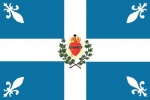 Drapeau Carillon Sacr
Drapeau Carillon Sacr
é-Coeur -
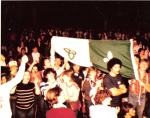 Drapeau franco-ontari
Drapeau franco-ontari
en dans la foul... -
Drapeau franco-ontari
en, 2006 -
 Jeune fille drapée du
Jeune fille drapée du
drapeau franco...
-
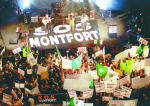 La foule lors du rall
La foule lors du rall
iement de 1997. -
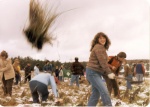 Lors de la démonstrat
Lors de la démonstrat
ion symbolique ... -
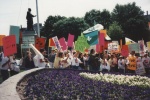 Manifestation à Queen
Manifestation à Queen
's Park en fave... -
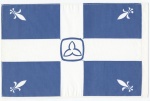 Modèle en tissu d'un
Modèle en tissu d'un
drapeau franco-...
Vidéo
Hyperliens
- Les Monuments de la francophonie de l'Ontario (in French)
- Les drapeaux franco-ontariens sur le site web du CRCCF (in French)

